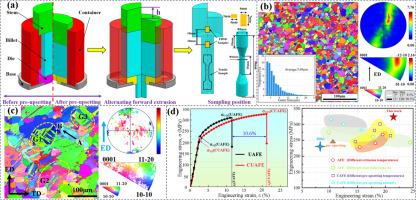Modification of texture in AZ31 magnesium alloy via cold pre-upsetting alternating forward extrusion
IF 13.8
1区 材料科学
Q1 METALLURGY & METALLURGICAL ENGINEERING
引用次数: 0
Abstract
Prefabricated twinning represents an effective strategy for optimizing the microstructure of extruded forming components and facilitating changes in texture. The study examines the incorporation of [10–12] twins into an AZ31 magnesium alloy billet via cold pre-upsetting deformation before alternating forward extrusion (CUAFE). The experimental results indicate that the initial presence of [10–12] twins is advantageous for the development of [10–10] and [[11], [12], [13], [14], [15], [16], [17], [18], [19], [20]] texture components during the extrusion process. In addition, different DRX mechanisms have different influences on the evolution of basal texture. The CDRX grains tend to preferentially select the [[11], [12], [13], [14], [15], [16], [17], [18], [19], [20]] texture orientation, weakening the [10–10] texture and enhancing the [[11], [12], [13], [14], [15], [16], [17], [18], [19], [20]] texture. However, most DDRX grains deviate significantly from the orientation of their surrounding original grain and do not have a preferred orientation. This is reflected in the mechanical properties of the CUAFE part. The tensile strength is 323.5 MPa, while the elongation is as high as 20.1%.

AZ31镁合金冷镦交替正挤压织构的改性
预制孪晶是优化挤压成形构件微观结构和促进织构变化的有效策略。该研究考察了在交替前挤压(CUAFE)前通过冷预镦粗变形将[10-12]孪晶纳入AZ31镁合金坯料中。结果表明,[10-12]孪晶的初始存在有利于挤压过程中[10-10]和[[11]、[12]、[13]、[14]、[15]、[16]、[17]、[18]、[19]、[20]]织构组分的发育。此外,不同的DRX机制对基底织构的演化也有不同的影响。CDRX晶粒倾向于优先选择[[11]、[12]、[13]、[14]、[15]、[16]、[17]、[18]、[19]、[20]]织构取向,弱化[10-10]织构,增强[[11]、[12]、[13]、[14]、[15]、[16]、[17]、[18]、[19]、[20]]织构。然而,大多数DDRX晶粒明显偏离其周围原始晶粒的取向,并且没有首选取向。这体现在CUAFE部件的力学性能上。拉伸强度为323.5 MPa,伸长率高达20.1%。
本文章由计算机程序翻译,如有差异,请以英文原文为准。
求助全文
约1分钟内获得全文
求助全文
来源期刊

Journal of Magnesium and Alloys
Engineering-Mechanics of Materials
CiteScore
20.20
自引率
14.80%
发文量
52
审稿时长
59 days
期刊介绍:
The Journal of Magnesium and Alloys serves as a global platform for both theoretical and experimental studies in magnesium science and engineering. It welcomes submissions investigating various scientific and engineering factors impacting the metallurgy, processing, microstructure, properties, and applications of magnesium and alloys. The journal covers all aspects of magnesium and alloy research, including raw materials, alloy casting, extrusion and deformation, corrosion and surface treatment, joining and machining, simulation and modeling, microstructure evolution and mechanical properties, new alloy development, magnesium-based composites, bio-materials and energy materials, applications, and recycling.
 求助内容:
求助内容: 应助结果提醒方式:
应助结果提醒方式:


